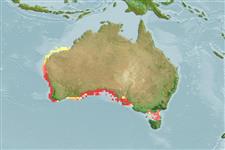Environment: milieu / climate zone / depth range / distribution range
Ecologia
marino associati a barriera corallina; distribuzione batimetrica 1 - 35 m (Ref. 9563). Subtropical
Eastern Indian Ocean: southern Western Australia and South Australia.
Size / Peso / Age
Maturity: Lm ? range ? - ? cm
Max length : 10.0 cm TL maschio/sesso non determinato; (Ref. 9563)
Spine dorsali (totale): 5; Raggi dorsali molli (totale): 21-22; Spine anali 1; Raggi anali molli: 17 - 18. This species is characterized by the following: D V,21-22 (rarely 21); A I,17-18 (rarely 17); 13-15 pectoral rays; 47-53 lateral-line scales; about 3 + 8 gill rakers; 3-4 predorsal scales, ending in a median naked area on nape with rest of nape scaled, the scales extending into posterior interorbital space and continuing in a single row to front of interorbital; ctenoid scales on nape and cheek; front of lower jaw with 10 canine teeth; with palatine teeth; upper edge of subopercle with a prominent sharp spine; vertical edge of preopercle serrate to irregular; body depth 4.45-5.35 in SL (18.7-22.6% SL); middle dorsal spine longest, 7.05-8.9% SL; truncate to slightly rounded caudal fin, 19.2-21.3% SL; membrane from last dorsal spine joined to base of first soft ray; whitish body with a straight to wavy black stripe from behind eye to upper base of caudal fin (stripe may be broken into blotches, especially on head); ventral half of body with a series of 10 dark bars; a broad median brown band on upper lip and two spots on side of lip; a long dark brown streak on side of lower lip; a large black spot basally in dorsal fin between spines II and V; soft portion of dorsal fin is pale with a small blackish spot at base of most rays, and 1-2 outer rows of small black spots on membranes; pale anal fin with a row of faint blackish spots at base of most rays and a middle row of small dark spots; pale caudal fin with a dusky lower margin (Ref. 57562).
Found on coastal reefs (Ref. 9563). A small territorial fish found in protected sandy and muddy areas near reefs and rocky outcrops from the shallows to depths of just over 35 m (Ref. 33839).
Life cycle and mating behavior
Maturità | Riproduzione | Deposizione | Uova | Fecundity | Larve
May, J.L. and J.G.H. Maxwell, 1986. Trawl fish from temperate waters of Australia. CSIRO Division of Fisheries Research, Tasmania. 492 p. (Ref. 9563)
IUCN Red List Status (Ref. 130435)
Threat to humans
Harmless
Human uses
Informazioni ulteriori
Nomi ComuniSinonimiMetabolismoPredatoriEcotossicologiaRiproduzioneMaturitàDeposizioneSpawning aggregationFecundityUovaEgg development
Age/SizeAccrescimentoLength-weightLength-lengthLength-frequenciesMorfometriaMorfologiaLarveDinamica popolazioni larvaliReclutamentoAbbondanzaBRUVS
BibliografiaAcquacolturaProfilo di acquacolturaVarietàGeneticaElectrophoresesEreditarietàMalattieElaborazioneNutrientsMass conversion
CollaboratoriImmaginiStamps, Coins Misc.SuoniCiguateraVelocitàModalità di nuotoArea branchialeOtolithsCervelliVista
Strumenti
Special reports
Download XML
Fonti Internet
Estimates based on models
Preferred temperature (Ref.
123201): 15.2 - 22.8, mean 17.7 °C (based on 212 cells).
Phylogenetic diversity index (Ref.
82804): PD
50 = 0.5000 [Uniqueness, from 0.5 = low to 2.0 = high].
Bayesian length-weight: a=0.00692 (0.00311 - 0.01538), b=3.06 (2.88 - 3.24), in cm total length, based on LWR estimates for this Genus-body shape (Ref.
93245).
Trophic level (Ref.
69278): 3.4 ±0.4 se; based on size and trophs of closest relatives
Resilienza (Ref.
120179): Alto, tempo minimo di raddoppiamento della popolazione meno di 15 mesi (Preliminary K or Fecundity.).
Fishing Vulnerability (Ref.
59153): Low vulnerability (10 of 100).
Nutrients (Ref.
124155): Calcium = 97 [41, 205] mg/100g; Iron = 0.873 [0.457, 1.605] mg/100g; Protein = 18.7 [16.4, 20.8] %; Omega3 = 0.164 [0.084, 0.313] g/100g; Selenium = 13.9 [5.5, 32.3] μg/100g; VitaminA = 65.3 [18.2, 241.9] μg/100g; Zinc = 1.31 [0.77, 2.08] mg/100g (wet weight);
